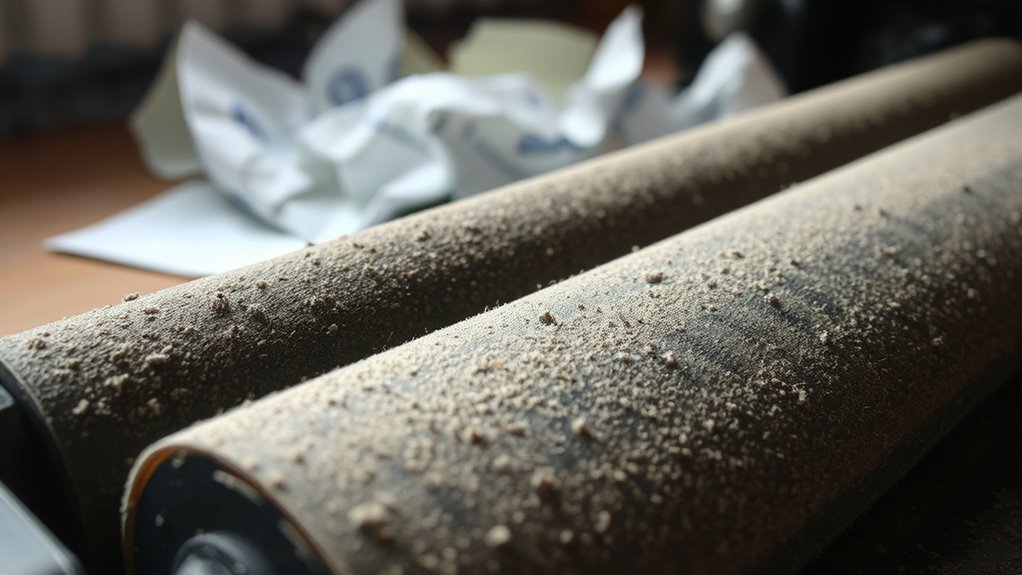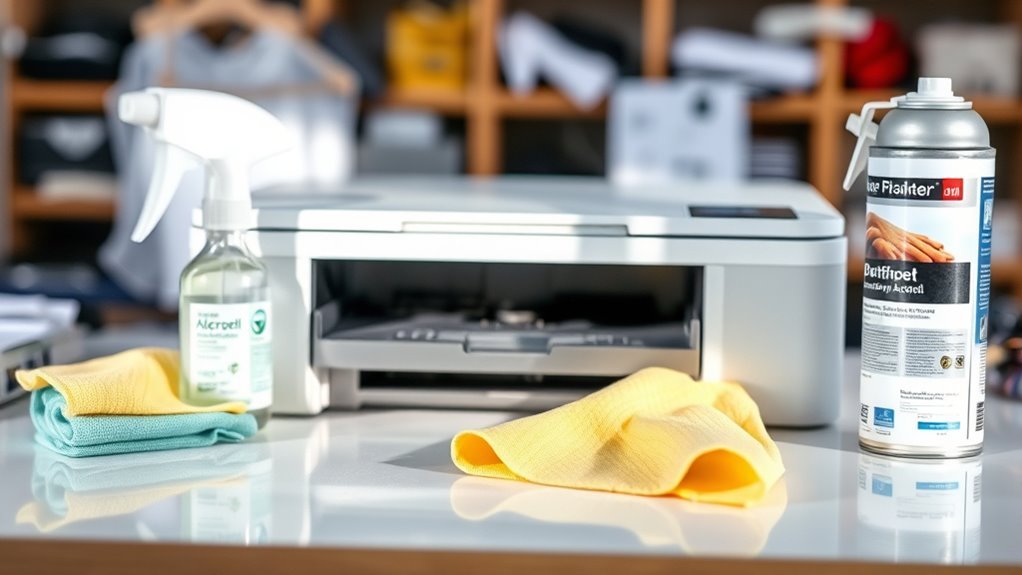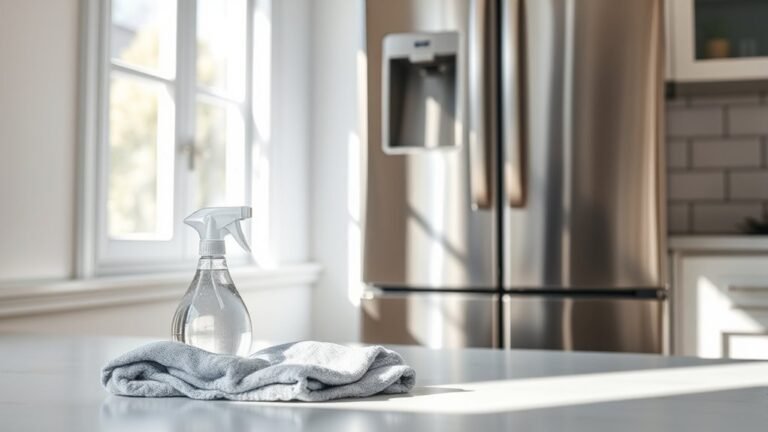Mistakes to Avoid When Cleaning Your Printer
When cleaning your printer, don’t use harsh chemicals or soak it with too much liquid—they can damage parts. Always unplug the device first to avoid electrical hazards and follow the manufacturer’s cleaning instructions to protect your warranty. Avoid neglecting rollers and regular maintenance, and don’t take the printer apart unless you know what you’re doing. Skipping routine cleanings or drying can cause jams and corrosion. Keep these in mind to maintain your printer’s smooth operation and learn how to care for it best.
Using Harsh Chemicals or Solvents

Although it might seem like a quick fix, using harsh chemicals or solvents can seriously damage your printer’s delicate components. You want your printer to last, so avoid those strong cleaners that promise to dissolve grime but instead cause solvent damage to sensitive parts like rollers and circuit boards. These chemicals can strip protective coatings and lead to malfunctions, limiting your printer’s freedom to perform reliably. Instead, choose gentle cleaning solutions specifically designed for electronics or simply use a damp, lint-free cloth. By steering clear of harsh chemicals, you maintain your printer’s integrity and extend its lifespan. When you handle cleaning with care, you keep your device running smoothly without risking costly repairs or replacements caused by solvent damage.
Cleaning the Printer While It Is Plugged In
When you’re cleaning your printer, never do it while it’s plugged in. This simple step is vital for your printer safety and your own protection. Cleaning a device connected to power exposes you to electrical hazards that can cause shocks or damage to the printer. Unplugging guarantees no accidental activation of moving parts or electrical components while you clean. It gives you the freedom to handle the printer’s interior and exterior without worry. Always disconnect the power cord before starting any cleaning process. This precaution minimizes risk and preserves your printer’s lifespan. Prioritize safety to avoid costly repairs or personal injury. Taking this small, deliberate action lets you maintain your printer effectively and confidently, without compromising your well-being or device integrity.
Ignoring the Manufacturer’s Cleaning Guidelines

You shouldn’t skip the manufacturer’s cleaning instructions if you want your printer to last. Using the recommended cleaning products and methods helps avoid damage and keeps your printer running smoothly. Always check the manual before you start cleaning.
Follow Official Cleaning Instructions
Since every printer model has unique components and cleaning needs, you should always follow the manufacturer’s cleaning guidelines. Ignoring official guidelines can lead to damage, voided warranties, or reduced performance. Stick to the recommended cleaning frequency to keep your printer running smoothly without unnecessary risks.
| Official Guidelines | Cleaning Frequency |
|---|---|
| Specific steps per model | Varies by usage and type |
| Approved cleaning tools | Often monthly or quarterly |
| Safety precautions | Avoids damage and errors |
Use Recommended Cleaning Products
Although it might be tempting to use household cleaners or generic products, sticking to the manufacturer’s recommended cleaning supplies is essential for your printer’s longevity. Using the wrong products can damage sensitive components and void warranties. Manufacturers specify recommended brands that are tested to clean effectively without harming your device. Following their advice helps maintain peak performance and prevents costly repairs. Pay attention to the suggested cleaning frequency as well; over-cleaning or neglect can both cause issues. By choosing approved cleaning solutions and adhering to the recommended cleaning frequency, you preserve your printer’s functionality and enjoy uninterrupted freedom to print whenever you need. Don’t risk damage for convenience—trust the guidelines to keep your printer running smoothly for years.
Using Excessive Water or Liquid Cleaners
You shouldn’t soak your printer with too much water or liquid cleaners, as excess moisture can damage internal components. Instead, use only the recommended cleaning solutions applied sparingly with a soft cloth. This approach helps keep your printer safe and functioning properly.
Risks of Overwetting
When cleaning your printer, using too much water or liquid cleaner can cause serious damage. Overwetting effects often lead to moisture damage inside the printer’s delicate components, including the circuit boards and rollers. Excess moisture can cause electrical shorts, corrosion, and even permanent malfunction. You want to avoid saturating any areas, especially around sensitive parts like the printhead or control panel. Instead, use just enough cleaner to dampen a cloth—never pour or spray liquids directly onto the printer. Being cautious with moisture helps maintain your printer’s performance and longevity. Remember, less is more when it comes to liquids. Overwetting not only risks damage but can also void your warranty, so always handle cleaning with care and precision.
Proper Cleaning Solutions
Choosing the right cleaning solution is crucial to keep your printer safe and functional. Avoid using excessive water or harsh liquid cleaners that can damage internal components. Instead, opt for eco friendly cleaners designed specifically for printer maintenance. They’re gentle yet effective, protecting your device while supporting your freedom to maintain it responsibly.
| What to Use | What to Avoid | Why It Matters |
|---|---|---|
| Eco friendly cleaners | Excessive water | Prevents internal damage |
| Isopropyl alcohol | Harsh chemicals | Protects sensitive parts |
| Microfiber cloth | Paper towels | Avoids scratches |
| Manufacturer’s wipes | Over-saturation | Guarantees longevity |
Choosing wisely keeps you in control and your printer running smoothly.
Neglecting to Clean Printer Rollers

One common mistake many overlook is neglecting to clean printer rollers regularly. These rollers play an essential role in feeding paper through your printer smoothly. When dirt, dust, or ink buildup accumulates, it disrupts roller maintenance and directly impacts printer performance. You’ll notice frequent paper jams, misfeeds, or faded prints if you skip this step. By dedicating a few minutes to gently clean the rollers with a lint-free cloth and appropriate cleaning solution, you guarantee consistent feeding and extend your printer’s lifespan. Don’t let a simple oversight limit your freedom to print whenever you want. Keeping your rollers clean is a straightforward way to maintain peak printer performance and avoid unnecessary frustration. Make roller care a regular part of your printer maintenance routine.
Using Paper Towels Instead of Lint-Free Cloths
You might think paper towels are a quick fix, but they leave lint behind that can clog your printer. Plus, their rough texture can scratch delicate surfaces, causing damage over time. Using a lint-free cloth is the best way to clean your printer safely and effectively.
Lint Residue Issues
Although it might seem convenient, using paper towels instead of lint-free cloths can leave behind tiny fibers that interfere with your printer’s performance. These lint residues may clog delicate printer components, causing jams or smudging your prints. To keep your printer running smoothly, opt for lint free alternatives specifically designed for printer maintenance. These cloths effectively remove dust and dirt without shedding fibers, preserving print quality and extending the life of your device. Avoid shortcuts that compromise your printer’s functionality; investing in proper cleaning materials gives you freedom from frequent breakdowns. By choosing the right tools, you maintain peak performance and enjoy hassle-free printing every time. Remember, proper printer maintenance isn’t just about cleanliness—it’s about protecting your investment and ensuring reliable output.
Surface Scratches Risk
When cleaning your printer, using paper towels instead of lint-free cloths can easily cause surface scratches. Paper towels often have rough textures and tiny fibers that can abrade delicate surfaces. You want to maintain surface protection to keep your printer looking and functioning like new. Scratches not only damage the exterior but can also trap dust and debris, reducing performance over time. For effective scratch prevention, it’s vital to choose cleaning tools designed to be gentle and non-abrasive. Avoid the temptation to grab whatever’s handy; preserving your printer’s surface means opting for materials that minimize friction and abrasion. By doing so, you guarantee your cleaning routine protects rather than harms, allowing you the freedom to keep your printer in top condition without worry.
Proper Cleaning Materials
Choosing the right cleaning materials is essential to avoid damaging your printer. One common mistake is using paper towels instead of lint-free cloths. Paper towels seem convenient, but their rough texture can scratch delicate surfaces and leave behind fibers that clog your printer. When selecting cleaning tools, opt for soft, lint-free cloths designed specifically for electronics. These material types minimize the risk of abrasion and residue buildup, preserving your printer’s performance and longevity. Remember, not all materials are equal—using the wrong ones can cause costly damage or reduce print quality. By choosing appropriate cleaning tools, you maintain your printer’s freedom to operate smoothly without unnecessary repairs. Stay precise and deliberate with your cleaning materials to keep your printer running freely and efficiently.
Skipping Regular Maintenance Cleanings
Even if your printer seems to be working fine, skipping regular maintenance cleanings can lead to problems down the line. Dust, ink buildup, and debris accumulate unnoticed, causing poor print quality and hardware issues. By sticking to a maintenance schedule, you guarantee your printer runs smoothly and avoids costly repairs. Regular cleaning keeps internal components free of obstructions, extends the device’s lifespan, and prevents unexpected breakdowns. Don’t wait for errors or faded prints to remind you—it’s easier to maintain than fix. Set reminders for regular cleaning sessions based on your printer’s usage and manufacturer recommendations. This simple habit gives you the freedom to print without interruptions, preserving both performance and reliability over time. Your printer will thank you.
Disassembling Printer Components Without Proper Knowledge
Regular maintenance can keep your printer running smoothly, but trying to fix issues by disassembling components without the right knowledge can cause more harm than good. When you start disassembling printer parts without understanding their functions, you risk damaging delicate printer components or voiding your warranty. Printers are intricate devices with sensitive mechanisms that require specific handling. Instead of taking apart your printer impulsively, follow manufacturer guidelines or seek professional help. If you’re determined to clean internal parts, only open areas clearly marked as user-serviceable. Remember, improper disassembly can lead to misalignment, broken parts, or electrical issues, restricting your printer’s freedom to operate. Protect your investment by respecting the complexity of your printer and avoiding risky disassembling printer attempts without proper knowledge.
Cleaning the Printer Only When Problems Arise
Waiting until you notice problems to clean your printer can lead to bigger issues down the line. Relying solely on troubleshooting techniques when your printer jams or prints poorly means you miss the benefits of preventive maintenance. Regular cleaning keeps dust, ink buildup, and debris from causing malfunctions, extending your printer’s lifespan and saving you from costly repairs. Don’t wait for error messages or poor print quality to prompt action. Instead, schedule routine cleanings to maintain smooth operation and avoid unexpected downtime. This proactive approach gives you freedom from frustrating interruptions and keeps your printer ready whenever you need it. By integrating preventive maintenance into your routine, you guarantee consistent performance without relying on last-minute fixes.
Overlooking the Importance of Drying After Cleaning
Maintaining a routine cleaning schedule is a great start, but neglecting to properly dry your printer afterward can cause serious problems. Moisture left inside can lead to corrosion, paper jams, or electrical issues. You need effective drying techniques and moisture control to keep your printer running smoothly. Use soft, lint-free cloths and allow sufficient air drying time before powering on your device. Avoid heat sources that could warp components.
| Drying Techniques | Moisture Control | Consequences of Neglect |
|---|---|---|
| Soft cloth wiping | Air drying | Corrosion |
| Compressed air use | Avoiding heat sources | Paper jams |
| Controlled humidity | Proper ventilation | Electrical failures |
| Patience in drying | Regular monitoring | Shortened printer life |
Drying is essential—don’t rush it.
Frequently Asked Questions
How Often Should I Replace My Printer’S Ink Cartridges?
You should replace your printer’s ink cartridges when you notice a drop in color saturation or print quality. The ink cartridge lifespan varies depending on usage, but typically, cartridges last for a few hundred pages. Keep an eye on faded colors or streaks—they’re signs it’s time for a swap. Staying on top of this guarantees your prints stay sharp and vibrant, giving you the freedom to create without interruption.
Can Dust Buildup Affect Print Quality?
Yes, dust buildup can definitely impact your printer’s performance, especially print clarity. When dust accumulates inside, it can interfere with the printer’s mechanisms and cause smudges or blurry prints. To keep your prints sharp and clear, it’s important to regularly clean your printer and remove any dust. Taking a little time for maintenance guarantees your printer stays reliable, letting you print freely without worrying about quality drops.
What’S the Best Way to Store Printer Paper?
Imagine opening your printer only to find your paper curled or stuck together. To avoid this nightmare, you’ve got to master printer storage. Always keep your paper sealed in its original packaging or an airtight container to protect it from paper humidity. Store it in a cool, dry place away from sunlight and moisture. That way, you’ll enjoy crisp, smooth prints every time, giving you the freedom to print without worry.
Is It Necessary to Update Printer Drivers Regularly?
Yes, you should update your printer drivers regularly. Keeping your driver software up to date guarantees your printer runs smoothly and helps avoid compatibility issues with your computer. It’s an important part of printer maintenance that can improve performance and fix bugs. Regular updates give you the freedom to print without interruptions or errors, making your printing experience more reliable and efficient. Don’t skip this simple step!
How Do I Fix Paper Jams Without Damaging the Printer?
When you face a paper jam, first turn off your printer to avoid damage. Gently pull the jammed paper in the direction of the paper path to prevent tearing. Avoid forceful yanks; patience is key. Check for small scraps left inside. Regular printer maintenance, like cleaning rollers and using the right paper type, minimizes jams. Taking these steps guarantees your printer stays free and functional with minimal hassle.






